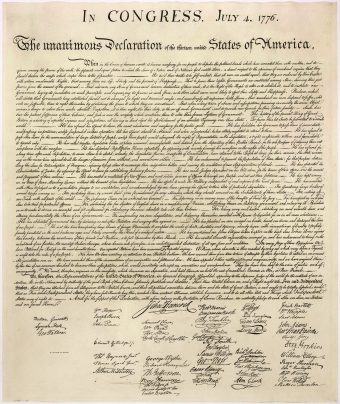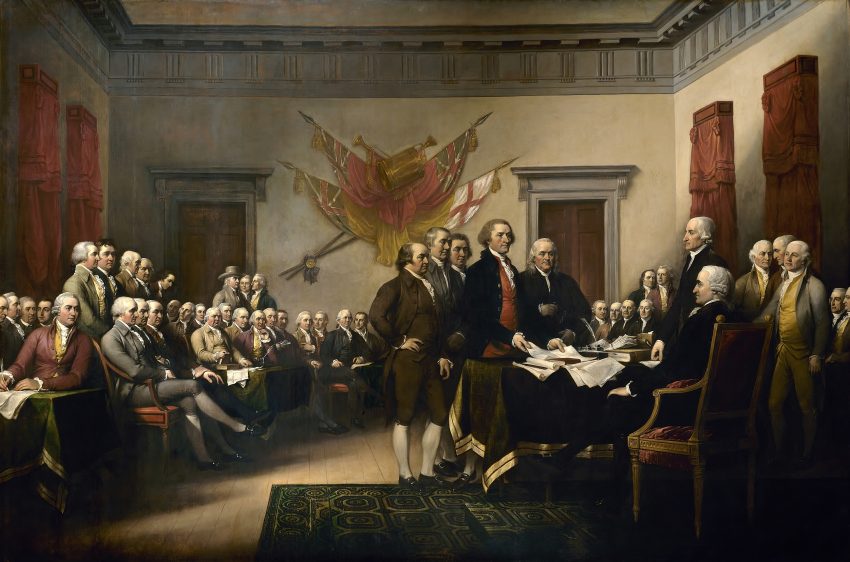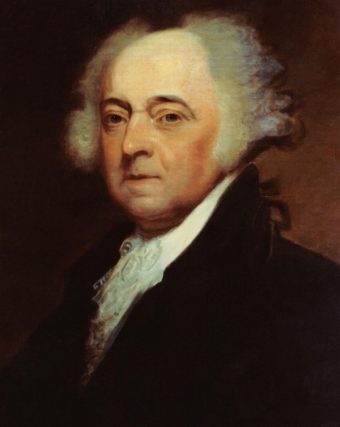 On today, July 4th, let’s examine a few bits and pieces of history related to America’s Independence and the patriotic displays that are still celebrated, nearly two and a half centuries after the birth of the United States.
On today, July 4th, let’s examine a few bits and pieces of history related to America’s Independence and the patriotic displays that are still celebrated, nearly two and a half centuries after the birth of the United States.
Why do we celebrate July 4th, and what are we celebrating?
The Declaration of Independence, which stated the unanimous intent of the 13 American colonies to separate and stand apart from Great Britain as a new nation, was adopted by the Continental Congress on July 4, 1776.
The 56 signers all agreed, “that all men are created equal, that they are endowed by their Creator with certain unalienable Rights, that among these are Life, Liberty and the pursuit of Happiness,” and that, “Governments are instituted among Men, deriving their just powers from the consent of the governed.” They also agreed that, “whenever any Form of Government becomes destructive of these ends, it is the Right of the People to alter or abolish it, and to institute new Government.”
The decision to declare independence was not one entered into lightly by Congress. In fact, it was a unanimous decision that came about only after much agonizing, debate, and prayer. The Signers believed strongly that given circumstances with Great Britain, especially under the tyrannical leadership of King George III, that America’s only way forward was to institute a new government.

A list of dozens “repeated injuries and usurpations” by the “present King of Great Britain” (George III) was put forth as evidences of his “absolute Tyranny over these States.”
In the end, the Signers placed their circumstances in the hands of God, “the Supreme Judge of the world” (a phrase that echoes Abraham from Genesis 18:25, who calls the Lord, “Judge of all the earth”), and:
That these United Colonies are, and of Right ought to be Free and Independent States; that they are Absolved from all Allegiance to the British Crown, and that all political connection between them and the State of Great Britain, is and ought to be totally dissolved; and that as Free and Independent States, they have full Power to levy War, conclude Peace, contract Alliances, establish Commerce, and to do all other Acts and Things which Independent States may of right do. And for the support of this Declaration, with a firm reliance on the protection of divine Providence, we mutually pledge to each other our Lives, our Fortunes and our sacred Honor.”
What’s the deal with fireworks and celebrations on the 4th of July?

In a letter to his wife, Abigail, Founding Father John Adams wrote:
The Second Day of July 1776, will be the most memorable Epocha, in the History of America. I am apt to believe that it will be celebrated, by succeeding Generations, as the great anniversary Festival. It ought to be commemorated, as the Day of Deliverance by solemn Acts of Devotion to God Almighty. It ought to be solemnized with Pomp and Parade, with Shews, Games, Sports, Guns, Bells, Bonfires and Illuminations from one End of this Continent to the other from this Time forward forever more.”
Wait… the second day of July?! Why the second?
Well, technically, the Continental Congress voted to adopt the Declaration of Independence on July 2, 1776. It was a momentous occasion. But it was not formally adopted until July 4, 1776, so that is the day we celebrate.
Apparently, John Adams always recognized July 2 as the day our nation declared its independence, going so far as forgo attending July 4th celebrations in his own means of protest.

In a fascinating bit of Founding Fathers trivia, it should be noted that John Adams (our second President) and Thomas Jefferson (our third President and man who was the primary author of the Declaration), both died on July 4, 1826 — the 50th anniversary of the formal adoption of the document they championed.
The evolution of Independence Day
While celebrations occurred regularly on July 4th after the first Independence Day (including George Washington doubling the rum rations to his soldiers on that day in 1778), Massachusetts was the first state to officially adopt the day as a holiday in 1781, but nearly a hundred years passed before Congress declared it an official federal holiday.
After the War of 1812, which some might think of as the American Revolution, Part II, Independence Day celebrations became a much bigger deal.
The Star Spangled Banner – Our National Anthem
As Americans, we know to stand, face the flag, and put our hands over our hearts whenever our National Anthem is played, but why do we do it?

In short, it was because the song was written by Francis Scott Key, inspired by events he witnessed during a particularly pivotal battle in the War of 1812, the defense of Fort McHenry during the Battle of Baltimore on Sept. 13, 1814. He was relieved and overjoyed to see the fort’s enormous garrison flag, sewn by Mary Young Pickersgill, flying in the wee morning hours after the battle.
If you want to talk about fireworks, you should have seen the “bombs bursting in air” that he saw from the harbor on that fateful night.
This video does a great job of illustrating the events of that battle and how they came to inspire our National Anthem:
If you’d like to read more bits and pieces of the history that led up to the American Revolution, you can visit this page. More articles are being added to this site regularly, so be sure to subscribe to The Gazette for updates.